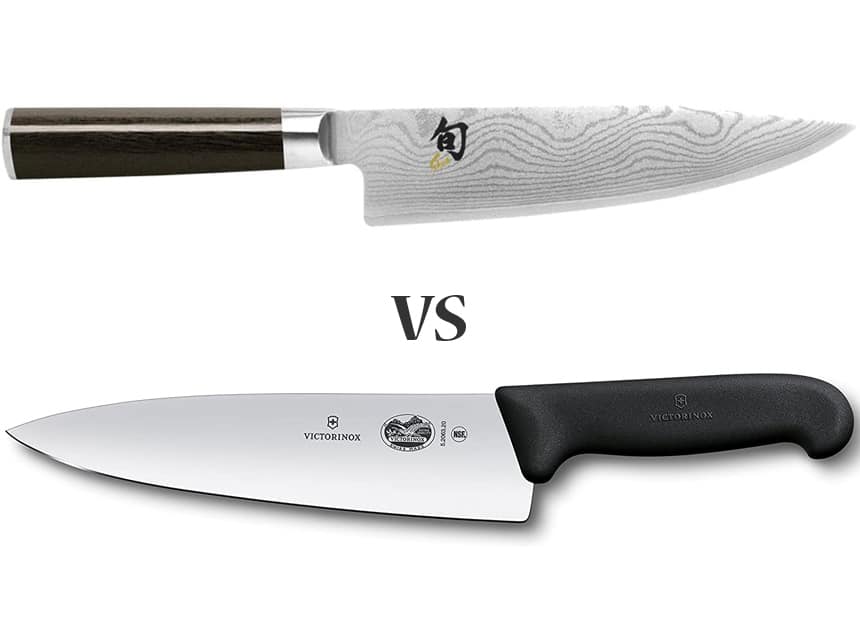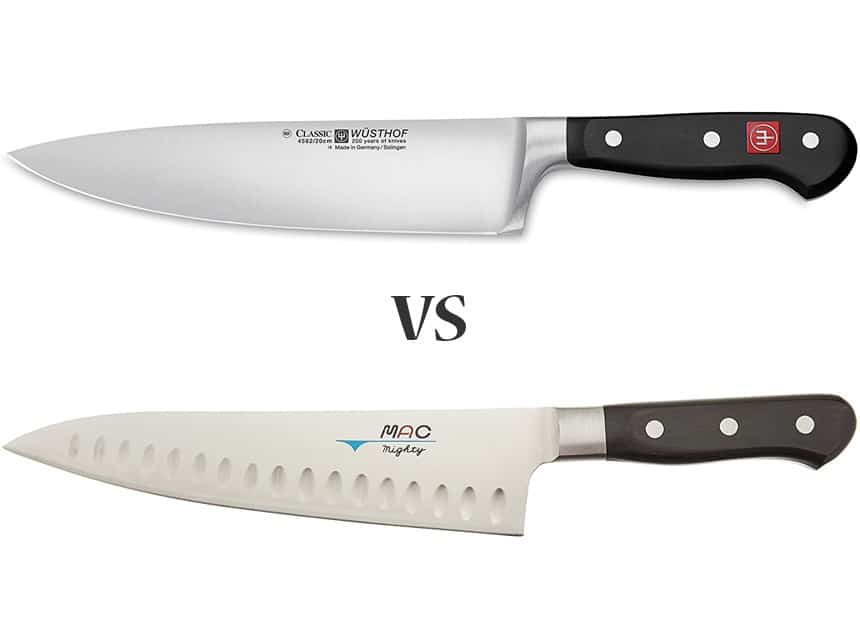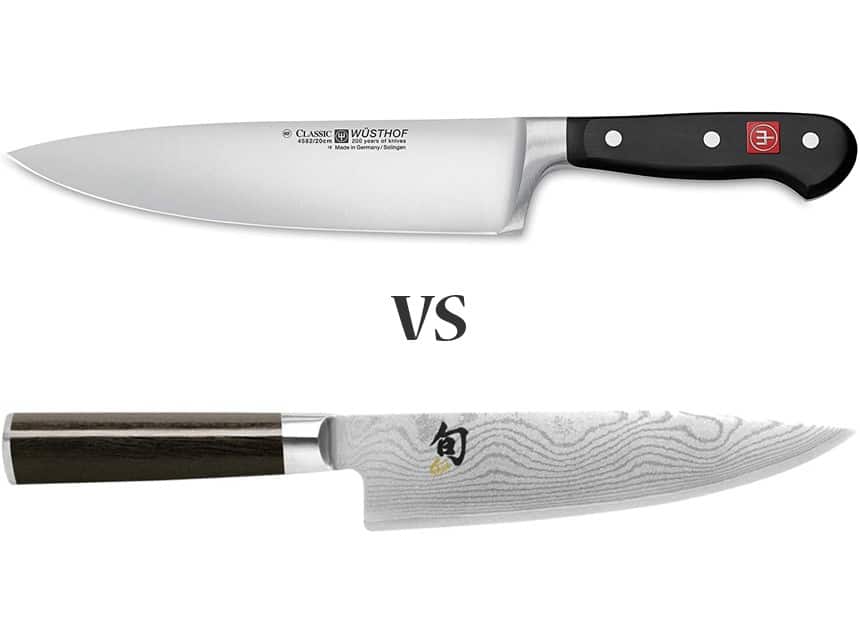
I love Japanese knives, they are beautiful and offer a super-sharp cutting edge.
A lot of people feel the same and they are getting more and more popular in western home kitchens. It’s also leading to more questions about the differences between some well-known Japanese and western knife brands.
Two great brands people are often deciding between are the Japanese brand Shun and the Swiss brand Victorinox.
They both produce quality knives, which then begs the question, which one would suit your needs best?
In this article, I’m going to tell you the differences between these two great brands. I’ll go in-depth into the details of each, talking about where they are made, what materials are used and the difference in price.
This article should provide all the information you need to select the right knife for your needs.
Shun knives offer a far superior, sharper cutting edge but they are significantly more expensive than Victorinox knives. Victorinox offers good quality western-style knives for the price, but don’t expect them to be nearly as sharp as a Shun.
| My recommendation | Current price |
| Shun Classic 8-Inch | View on Amazon (opens new tab) |
| Victorinox Rosewood Chef’s Knife 8-Inch | View on Amazon (opens new tab) |
Shun vs Victorinox – Comparison Table
Here is my summary comparison table for each brand. This is mostly based on their main range of knives; the Shun Classic and the Victorinox Fibrox Pro.
For a more in-depth look at each category then check out the rest of the article below.
| Category | Shun | Victorinox |
| Country of Manufacture | Japan | Switzerland |
| Steel type | VG-MAX | X50CrMoV15 |
| Rockwell hardness | HRC 61 | HRC 56 |
| Factory edge | 16 degrees (double bevel) | 15 degrees (double bevel) |
| Handle material | Pakkawood (wood/resin composite) | TPE (thermoplastic) |
| Price range | $160 – $180 (Classic) | $50 – $60 (Fibrox Pro) |
| Main benefit | Far sharper | Low price, comfortable design |
| My recommendation | Shun 8-Inch Classic (view on Amazon) | Victorinox Rosewood Chef’s Knife 8-Inch (View on Amazon) |
Shun vs Victorinox – Where are they made
| Brand | Country of manufacture |
| Shun | Japan |
| Victorinox | Switzerland |
All Shun knives are manufactured in the Japanese city of Seki. Seki is known as the knife capital of Japan, with a population of only 90,000 it lies around 150 miles from Toyoko but is the central hub for all of Japan’s major knife manufacturers.
Shun knives are designed with a Japanese influence but to suit the demands of the Western market, with a larger focus on durability compared with other Japanese brands.
Victorinox produces all their knives in Ibach, Switzerland.
Victorinox is a very interesting company as they are the original creators of the Swiss Army Knife, in fact, they produce around 45,000 Swiss Army Knives every single day.
The company was founded in 1884 and since then has expanded into other products such as chef’s knives and watches.
I think the practicality that you’d expect from a Swiss Army Knife is reflected in many of the features of Victorinox’s kitchen knives, which certainly focus more on durability than sharpness, but we’ll come to that next.
Both of these brands have a rich heritage, you can be assured that both these brands offer plenty of knife making experience.
But the focus of each knife is very different, and that’s best shown when we look at the steel used for the blades.
Shun vs Victorinox – What steel do they use
The steel used in knives will often change depending on which range you pick.
Here I’m going to focus on the most popular range for both Shun and Victorinox knives.
They actually use the same steel, there is just a slight variation in hardness, most likely due to the way the steel is treated during manufacture.
| Brand | Steel type | Rockwell hardness |
| Shun Classic | VG-MAX | HRC 61 |
| Victorinox Fibrox Pro | X50CrMoV15 (stamped) | HRC 56 |
The Shun Classic range uses their own Japanese steel VG-MAX. Not all Shun knives are made from VG-MAX, it’s their own specially formulated steel with the aim of VG-MAX being an improvement on the (already very good) VG-10 steel.
VG-MAX is a fantastic steel. It’s been made with a Japanese influence in mind but also with a strong focus on appealing Western markets.
That means it’s got a fantastic balance between strength and durability.
We can see why when we look at VG-MAX’s levels of Carbon, Vanadium and Chromium.
This is a high-Carbon steel, with a Carbon content of 1.1%. Often, such a high Carbon steel will be more prone to chips in the blade. As materials become harder they usually become more brittle; however, that’s not quite the case for VG-MAX.
To understand why we’ll look at the Vanadium content first. It’s pretty high, at 0.3%, that’s not as high as the Victorinox’s X50CrMoV15 Vanadium content but for a high Carbon blade it compares very well.
As a result VG-MAX is more resistant to wear than most other high Carbon steels.
The Chromium content is higher than X50CrMoV15 at 16%. That makes VG-MAX one of the best stainless steel on the market at resisting rust.
Those two factors make this a very durable high Carbon steel.
The Victorinox’s X50CrMoV15 steel will still be more durable than the VG-MAX, simply because its Carbon content is so much lower. However, Shun has done a fantastic job of creating a high Carbon knife that is still very durable.
Victorinox knives use a German steel called X50CrMoV15.
It’s popular steel amongst producers of quality western-style knives. That’s because it has a particular focus on durability, whilst retaining enough strength for a sharp edge.
The main elements of interest within X50CrMoV15’s composition are Carbon, Vanadium and Chromium.
The Carbon content is 0.55%. That’s not particularly high when comparing it with other quality knives; however, it’s high enough to provide sufficient strength in the blade for a 15 – 20 degree angle on each side, which is standard for western knives.
The big benefit of not having a very high Carbon content is that higher Carbon steels are usually more brittle, therefore the 0.55% content keeps the blade durable.
That’s the same with the strong Vanadium of 0.4%, Vanadium improves the resistance to wear of the steel also adding to its durability.
The Chromium content is 15% is what the 15 in X50CrMoV15 represents. Chromium is vital for the durability of steel as it’s what makes stainless steel resistant to rust.
Steel need only be 10.5% to be considered stainless, so a 15% content is high and makes this a quality stainless steel, very unlikely to rust unless extremely mistreated by the owner.
Overall the main difference between the Shun’s VG-MAX steel and Victorinox’s X50CrMoV15 steel is that X50CrMoV15 has been made with a very strong focus on durability, with less regard for edge retention, whereas VG-MAX is much more focused on hardness, allowing for a finer, and therefore sharper edge.
This is reflected in their comparative Rockwell Hardness (HRC).
Shun knives have a much higher HRC than Victorinox and thus the steel is a lot harder and able to hold a sharper edge.
Shun vs Victorinox – How sharp are they
Once again I’m going to focus on the most popular knives from each brand for this comparison.
You will experience a far sharper edge using Shun knives than Victorinox knives due to the steel of the Shun knives being much harder.
| Brand | Factory edge | Rockwell hardness |
| Shun Classic | 16 degrees (double bevel) | HRC 61 |
| Victorinox Fibrox Pro | 15 degrees (double bevel) | HRC 56 |
Sharpness is vital when looking for a knife, but in this case, there’s a bit more to it than just looking at which knife has the smallest angle of its edge.
Usually, the smaller the angle the sharper the blade. However, there are other considerations that are particularly important when comparing these two knives.
Harder knives will hold a sharper edge for longer. The Shun uses much harder steel than Victorinox.
Shun use their own Japanese steel and that tends to have a focus on hardness, in order to create a sharper edge.
So, even though Victorinox knives are made with a similar factory edge of 15 degrees, the Shun knife will actually hold its edge for much longer.
That results in a significantly sharper blade that needs to be sharpened far less often.
Shun vs Victorinox – What are the handles made from
The material used for handles is a vital and often overlooked feature of any knife.
A quality handle is often the sign of a quality overall knife. Handles need to be made from a durable material that can withstand all the heat and moisture fluctuations knives can experience in the kitchen.
Once again we’ll focus on the two main ranges from each brand, the Shun Classic and Victorinox Fibrox Pro.
| Brand | Handle material |
| Shun Classic | Pakkawood (wood/resin composite) |
| Victorinox Fibrox Pro | TPE (thermoplastic) |
Shun use a wood/resin composite called Pakkawood for their knife handles.
Pakkawood is extremely common in knife handles for quality Japanese knives, although many non-Japanese knife manufacturers around the world have begun to use it as well.
Pakkawood is a great material for knife handles, it’s more dense and durable than real timber. That means it’s more resistant to wear and tear and won’t crack over time as timber handles might.
The versatility of design also makes it a popular choice, it can be dyed all sorts of colors and will often give the appearance of a true wood finish.
Pakkawood is very resilient to temperature and moisture changes and makes a terrific material of choice, it also adds to the Japanese influence of the knife with Pakkawood being a popular Japanese knife handle material.
Victorinox Fibrox Pro a thermoplastic material for their knife handles called TPE.
It is worth mentioning that whilst Victorinox’s most popular range uses TPE; they also have a knife that uses a very attractive Rosewood timber, which is actually my personal Victorinox recommendation.
But as the TPE knives are by far Victorinox’s most popular, I’m focusing on that.
Thermoplastic materials like these are ideal for knife handles due to their extreme durability.
Being a thermoplastic means it’s extremely resistant to temperature and moisture changes.
It’s a fantastic material to use for knife handles, that will undergo all sorts of pressures and it makes sense to use this material for your main range, which is usually your more practical range.
TPE has more flex in it than other thermoplastic pics, as a result, the TPE handle Victorinox use isn’t quite as tough as materials like POM, but on the upside it does offer a good amount of grip due to the texture of the surface.
Both TPE and Pakkawood are good quality knife handle materials. Pakkawood is the higher quality material, but since Victorinox knives do cost significantly less, TPE is still a good choice of material for that price range.
Talking of price, let’s look at that next.
Shun vs Victorinox – How much do they cost
Both these brands have wide ranges of knives all at differing price ranges.
To allow for a fairer comparison I’ve categorized three of their major ranges that represent their highest and lowest cost knives.
I’ve tried to compare similar knives, sticking to 8 Inch Chef’s knives or the closest equivalent they have in the range.
In brackets next to the general price range you’ll see the name of the range.
These prices are rough estimates. Prices do change over time but this is intended as a rough guide.
| Brand range | Shun | Victorinox |
| Premium | $200 – $250 (Premier) | Not Applicable |
| Standard | $160 – $180 (Classic) | $110 – $130 (Professional) |
| Value | $80 – $100 (Sora) | $50 – $60 (Fibrox Pro) |
What is clear is that these two brands offer their knives at very different price ranges.
Victorinox is a brand that generally lies at the budget end of the price scale. That’s fine if it’s what you’re looking for. Victorinox makes a really quality knife for what you pay.
However; the clear superiority of Shun knives shows in their price. As I’ve discussed above, the steel is much harder, and therefore sharper and the general build quality of Shun knives is on another level to the more budget Victorinox.
Shun vs Victorinox – What is the difference
Now that we have looked at the design, materials, background and price of these brands we can fully understand the difference, and you should be able to make an informed decision on which knife is correct for you.
The main differences between Shun and Victorinox knives is the sharpness and durability, created from the steel used and the overall design of each knife.
| Brand | Main benefits |
| Shun | Far sharper, Japanese design |
| Victorinox | Low price, comfortable design |
The Shun is the sharper blade. It’s a very high Carbon knife at 1.1% Carbon and has great edge retention.
The Shun is also remarkably durable for a high Carbon knife and is certainly one of the most durable Japanese knives available.
However, like most western style knives, Victorinox knives are purpose built for durability so a high Carbon knife is never going to be as durable. They will always be more prone to chipping.
The other major difference is the design.
The Shun is much more Japanese in its appearance. It’s straight, oval handle is typically Japanese and could take some getting used to, although the blade edge has clearly been curved to suit the rock chopping style Western cooks tend to use.
With that understood, it should now be easy to choose between the two knives.
Shun vs Victorinox – Which is better for you
I have to stress that these are both brilliant knives. There is no clear winner, it’s really down to which one suits your needs the best.
For a busy family kitchen, where multiple people might be using the knife, then I would recommend the Victorinox.
It’s more durable than the Shun. Don’t get me wrong, Shun Classics are very durable knives, but any high Carbon knife just won’t match the Victorinox for durability.
The Victorinox is also a much more classic western Chef’s knife design which is generally preferable if multiple people will be using it.
If sharpness and quality is what you care about, then the Shun is the best choice for you.
The Shun Classic is a brilliant knife. VG-MAX steel is one of my favorites as, even though it can’t quite compare with the durability of Victorinox, it is still extremely durable for Japanese high Carbon steel.
As long as you treat a Shun with a reasonable amount of respect then it won’t rust, chip or snap and you will have a razor sharp edge.
The design of the knife should also be a consideration. Even though they’ve been tailored in many ways for the Western market, Shun Knives are still distinctly Japanese, with that straight, oval shaped handle.
My Shun Recommendation

View the 8-Inch Shun Classic on Amazon (opens new tab)
The Shun Classic 8-Inch is a superb knife and I’d highly recommend it.
The Shun Classic is an absolute masterpiece of merging Japanese and Western influences and I’d highly recommend it to anyone interested in quality knives that are a bit different.
I don’t think you could be disappointed with this knife.
My Victorinox Recommendation

View the 8-Inch Victorinox Rosewood Chef’s Knife on Amazon (opens new tab)
The Fibrox Pro, with its thermoplastic handle, might be the most popular Victorinox knife, but it’s not my personal recommendation.
For a similar price, you can get the Victorinox Rosewood Chef’s Knife. It uses the exact same steel but has a beautiful Rosewood handle instead of the thermoplastic.
Rosewood is hard, so it’s still plenty durable, and I think the style it gives the knife is really hard to match at this price range. It certainly looks like a knife that would be more expensive than it actually is.
The handle shape is a classic design, along with the curved blade edge it’s ideal for rock chopping and is a lightweight knife overall.
For a knife around the $50 mark, you’ll find it hard to find another knife as stylish and as high in quality as this one.

